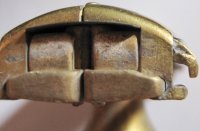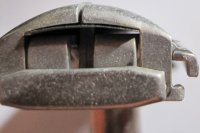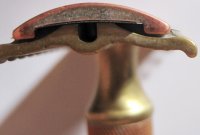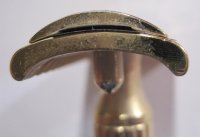The Ernst Sharff Rapide, my loudest razor by far. Makes the sound of a butter knife scraping burnt toast. Love it, will not nick nor bite. Get a Rapide and sell your styptic pencil.

You are using an out of date browser. It may not display this or other websites correctly.
You should upgrade or use an alternative browser.
You should upgrade or use an alternative browser.
What Makes the Razor Sing?
- Thread starter Dovo1695
- Start date
Ron R
I survived a lathey foreman
The Ming Sing 2000 razor has a loud scrapping toast audio sound that I really enjoy
 . It could be from the way the cap is attached to the base plate with spring wire clips mechanically holding that may help the audio increase?(the razor gives a good shave and is economical)
. It could be from the way the cap is attached to the base plate with spring wire clips mechanically holding that may help the audio increase?(the razor gives a good shave and is economical)

 . It could be from the way the cap is attached to the base plate with spring wire clips mechanically holding that may help the audio increase?(the razor gives a good shave and is economical)
. It could be from the way the cap is attached to the base plate with spring wire clips mechanically holding that may help the audio increase?(the razor gives a good shave and is economical)
I had this thread in mind when I shaved this morning. My regular daily is the Rockwell 6S plate #3 and the I throw a Feather AS-D2 in there occasionally for a change or after an experiment (blade, soap) has left my face a bit raw.
These two make markedly different sounds; the Feather is considerably quieter with a dead toe while the Rockwell can be heard from an adjacent room and is singier. The thing that strikes me though is this, no matter which razor I use or whether it's shimmed or not, the minimum level of noise is quite consistent. Meaning, there is a noise floor which all my razors will reach, but only some are louder, none are quieter.
As a former musician and vocalist I like to think I have a pretty good ear. As an Engineer I have a pretty good grasp of the physics and mechanics involved too. I observe that there are two distinct characters to the sound produced during a shave; one is the 'singing' or resonating sound of steel which has a distinctive start and decay, the other is a more dead snap which I suspect is the bristle and skin snapping back to rest after the blade has passed.
Recently I tried shimming the Rockwell plate #1 to remove some flex and simulate plate #3, the idea being to test whether extra rigidity improved the shave by removing blade flex under the cap and reducing the tendency for the blade to bend in the direction of the skin under load. The result was that it's markedly quieter, which affirms the notion that clamp distance has a bearing on noise. However, it wasn't any quieter than the minimum I usually experience.
This morning I shaved one pass with the shimmed Rockwell and one pass with the Feather and they sounded almost identical. No real 'singing' from the razor, but it seems the 'dead snap' is still present.
I don't have any to test with, but if someone can perform a test with some ear plugs I think this will highlight the different sounds. The ear is really good at picking up sounds from the face and head, so if you have ear plugs in while shaving you may only hear the 'dead snap' of the bristles/skin while the 'singing' may be missing. Or I could grow a third arm and stick my fingers in my ears while shaving.
These two make markedly different sounds; the Feather is considerably quieter with a dead toe while the Rockwell can be heard from an adjacent room and is singier. The thing that strikes me though is this, no matter which razor I use or whether it's shimmed or not, the minimum level of noise is quite consistent. Meaning, there is a noise floor which all my razors will reach, but only some are louder, none are quieter.
As a former musician and vocalist I like to think I have a pretty good ear. As an Engineer I have a pretty good grasp of the physics and mechanics involved too. I observe that there are two distinct characters to the sound produced during a shave; one is the 'singing' or resonating sound of steel which has a distinctive start and decay, the other is a more dead snap which I suspect is the bristle and skin snapping back to rest after the blade has passed.
Recently I tried shimming the Rockwell plate #1 to remove some flex and simulate plate #3, the idea being to test whether extra rigidity improved the shave by removing blade flex under the cap and reducing the tendency for the blade to bend in the direction of the skin under load. The result was that it's markedly quieter, which affirms the notion that clamp distance has a bearing on noise. However, it wasn't any quieter than the minimum I usually experience.
This morning I shaved one pass with the shimmed Rockwell and one pass with the Feather and they sounded almost identical. No real 'singing' from the razor, but it seems the 'dead snap' is still present.
I don't have any to test with, but if someone can perform a test with some ear plugs I think this will highlight the different sounds. The ear is really good at picking up sounds from the face and head, so if you have ear plugs in while shaving you may only hear the 'dead snap' of the bristles/skin while the 'singing' may be missing. Or I could grow a third arm and stick my fingers in my ears while shaving.

Puccini. You play some Puccini loud enough and the razor always sings along.
The Feather never sings, but then they didn't write opera in Japan either. Do I need a Fatip for that to work?Puccini. You play some Puccini loud enough and the razor always sings along.
I never really thought about where it comes from. I just always figured that when I do hear it, it meant I didn't get that area of my face very well. I go over it again, and the sound goes away. Oh, and my face is smoother. Is it technique related? Could be. I usually notice it most on the side of my face near the area where sideburns would be. I don't ever notice it on my chin for example.
I don't think the sound has much to do with blade flex. I have several injector razors that sing and I know for a fact that injector blades don't flex. I think it has more to do with the design and how well a piece transmits the natural vibrations from the blade to the razor. Then the design of the razor either enhances and amplifies that vibration or it muffles the vibration.
I have a vintage Sheraton that sings about as loud as any vintage DE I have tried (that would be over 100 razors). And I have several SE and injector razors as well. Some of those equal or exceed the Sheraton. And all the SE razors have very rigid blades and the injectors are held in place at the blade edges in most injectors.
I don't buy the quieter razor is better theory because I have too many loud razors that shave perfectly and leave the face just as unmolested as my quiet razors.
I am an Excalibur member and a Century club member as well. And I shave in the super steep mode with some and the super shallow mode with other razors. The steep vs. shallow argument is also one which I think too much is made of it. I have razors that will go over 100 shaves with the steep angle and ones that will go over 100 with the shallow angle.
Blade rigidness is not the ultimate answer to the best shave anymore than any other single element is the ultimate answer. For some it means much for others it is not as necessary.
In general, the stiffer the blade the less skill is necessary to achieve a comfortable and close shave, but always remember that there are some shavers who can put a blade on the end of a stick and get BBS with no weepers.
Their technique and skill far surpass those of us mere mortals.
My grandfather was one who could shave with the blade on a stick, I saw him do it more than once on camping trips. And he hardly ever used shave cream. Just wet his face and shaved away.
I have a vintage Sheraton that sings about as loud as any vintage DE I have tried (that would be over 100 razors). And I have several SE and injector razors as well. Some of those equal or exceed the Sheraton. And all the SE razors have very rigid blades and the injectors are held in place at the blade edges in most injectors.
I don't buy the quieter razor is better theory because I have too many loud razors that shave perfectly and leave the face just as unmolested as my quiet razors.
I am an Excalibur member and a Century club member as well. And I shave in the super steep mode with some and the super shallow mode with other razors. The steep vs. shallow argument is also one which I think too much is made of it. I have razors that will go over 100 shaves with the steep angle and ones that will go over 100 with the shallow angle.
Blade rigidness is not the ultimate answer to the best shave anymore than any other single element is the ultimate answer. For some it means much for others it is not as necessary.
In general, the stiffer the blade the less skill is necessary to achieve a comfortable and close shave, but always remember that there are some shavers who can put a blade on the end of a stick and get BBS with no weepers.
Their technique and skill far surpass those of us mere mortals.
My grandfather was one who could shave with the blade on a stick, I saw him do it more than once on camping trips. And he hardly ever used shave cream. Just wet his face and shaved away.
Well said. I agree with everything you said, especially the snippet I just quoted.Blade rigidness is not the ultimate answer to the best shave anymore than any other single element is the ultimate answer.
Like you, I'm av Excakibur Century Club member and have close to 100 DE razors and one of my top DE shavers, the Wardonia Mk.VI, has virtually no blade support.

My 1940 Gillette Regent, D2 SS, NEW SC and Fatip Grande.




My Grande and the NEW SC are very quiet. With a Gillette Yellow in my Grande I dont hear or feel anything. The SS is a bit louder, but my Regent is much more noticeable. With a very shallow angle I can quiet it considerably, but with a steep angle, its quite noticeable.
I think its differences in rigidity, exposure and angle, both in the geometry of the head and angle used in shaving.




My Grande and the NEW SC are very quiet. With a Gillette Yellow in my Grande I dont hear or feel anything. The SS is a bit louder, but my Regent is much more noticeable. With a very shallow angle I can quiet it considerably, but with a steep angle, its quite noticeable.
I think its differences in rigidity, exposure and angle, both in the geometry of the head and angle used in shaving.
Straight razors sing as well and there is not a lot of flex in those edges. The cutting of the hair must have a significant addition to the sound. Hair can take a lot of tension so that may deliver a sound effect as it is cut which adds to the overall sound effect.
I've been staring at that picture and for the life of me I can't imagine how that razor works. Somehow, I find that makes me really rather happy in that it seems to me that there's always something new to learn on this forum!
Well said. I agree with everything you said, especially the snippet I just quoted.
Like you, I'm av Excakibur Century Club member and have close to 100 DE razors and one of my top DE shavers, the Wardonia Mk.VI, has virtually no blade support.

- Thread starter
- #32
Blade rigidness is not the ultimate answer to the best shave anymore than any other single element is the ultimate answer. For some it means much for others it is not as necessary.
Good point. I'm not asserting that rigidity is the ultimate answer to the best shave by any stretch of the imagination. I do think that it plays a role though. To be honest, I don't have a clue what makes some razors shave better than others, but I'm incredibly curious about it. For the purposes of this thread, what interests me whether or not there is any correlation between blade rigidity & razor "volume". Some razors are louder than others, and some are more rigid than others. Proponents of "rigid blade theory" suggest that free-end distance plays an important role in rigidity. It seems logical that free-end distance plays a role in razor "volume" as well, in that the more blade exposure there is, the easier it is for vibrations to occur. I thought it was fascinating that Stan from Above the Tie, who designs exceptional razors for a living, said that he uses "free-end distance" to literally "tune" the level of volume that a razor produces intentionally (he used the term "blade exposure" but he describes precisely the same thing). I'd say that's a compelling argument in the very least that "free-end distance" plays a role in razor volume.
I have no idea what conclusion to draw from that, but I'm a bit of geek and I think it's a fascinating puzzle.

The "sing" you notice is caused by the amount of blade exposure designed into the razors head most notably the cap. This exposure is the distance from the edge of the cap to the cutting edge of the blade. Our Above the Tie stainless razors have a larger blade exposure which allows more flex in the blade resulting the the razor "singing". I incorporated this feature into our razors because I believe the additional audible feed back helps the shaver to find and maintain a proper shave angle which results in a better shave.
Some guys really enjoy this quality while some do not value it as highly. So I designed our offer our Windsor razor line with a more conventional blade exposure to provide additional razor differentiation for our customers.
Stan
Similar threads
- Replies
- 21
- Views
- 2K
- Replies
- 47
- Views
- 3K

